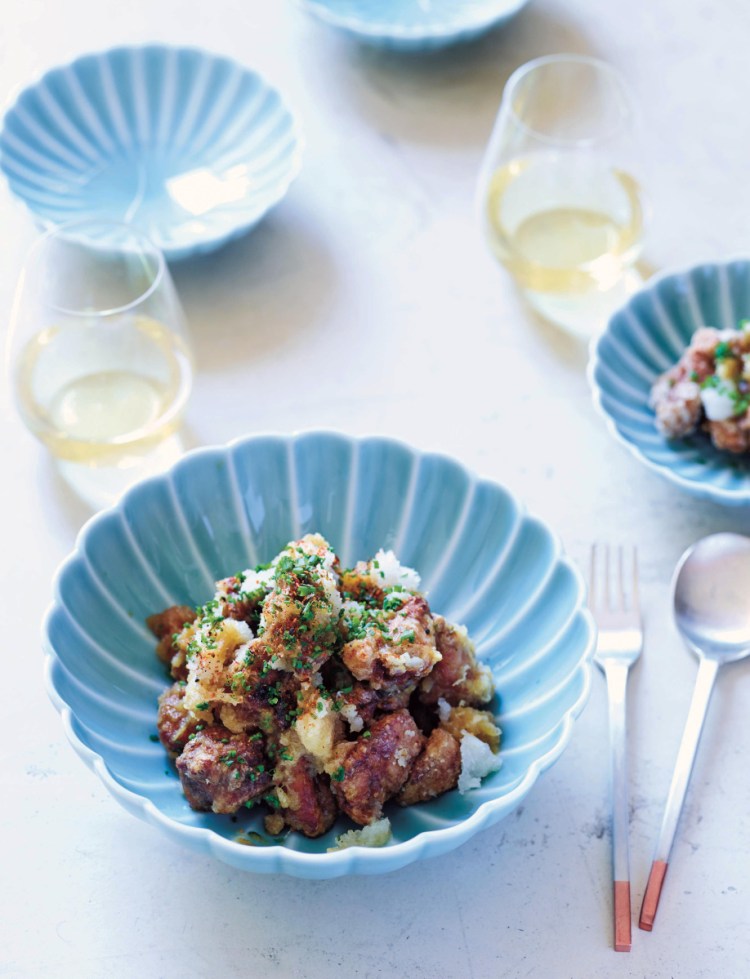After the winter holiday stretch that runs from Thanksgiving to New Year’s, it’s not uncommon to think to oneself some version of, “Wow, I need to tighten up this ship!” Cookies, cheese, stollen, prime rib, wine, bloody Marys – so much of these and you can’t stop eating because everything is delicious and (if you’re lucky) everywhere.
But it can be hard to eat better based on mere resolve. Lots of other things must change, too, like available ingredients, your shopping patterns and the time you allot to cooking. Whenever I get this feeling, I do the easier thing – retreat and eat at Japanese restaurants for a few weeks.
Japanese food customs often seem better, or at least healthier than ours. “Hara hachi bun me” is a Confucian saying and Japanese practice meaning something like “eat until you are 80 percent full.” It will show up in quickly in an internet search for “healthiest diets in the world,” and it makes an appearance in the introduction to “CIBI: Simple Japanese-inspired meals to share with family and friends.”
CIBI is a café, event space and shop in Melbourne, Australia that also has an outlet in Tokyo. Proprietors Meg and Zenta Tanaka brought together their careers in food and wine and architecture to create the place ten years ago. The Tanakas use the motto “head, hands, heart” to embody their business philosophy. “At CIBI,” they write in their introduction, “we like to combine who we are with where we are, and want the flavor of our meals to reflect this.”
This beautiful, practical cookbook exports that spirit. With over 100 well-written recipes, recommendations for substitutions, a pantry and tool index, and perfectly styled photographs, it makes a great addition to an omnivore’s kitchen, especially for eaters – like me – who love Japanese food and need to be going out to eat less.
Meg Tanaka unlocks many small, simple processes that can make Japanese home-cooking seem daunting. As long as you have access to an Asian grocer, many of the recipes are simple and easily achievable. The book opens with the basics, recipes for Perfect Stovetop Rice, dashi (Japanese soup stock), My Grandmother’s Miso Soup and tamago-yaki, a Japanese omelet. Unfortunately, you need a special pan for that last one.
The recipes are rooted in Meg Tanaka’s rural Japanese upbringing, but also reflect her global travels and Australian anchoring in such dishes as Slow-Cooked Chicken with Green Olives from Southern France and the CIBI Egg and Potato Sandwich, a griddled sandwich filled with a cheesy, mayonnaise-y egg and potato salad.
The largest section in the CIBI cookbook is given over to vegetables, with 74 pages covering salads, stews, squash croquettes, and root vegetable gratins. The Tanakas write that at CIBI, “We serve our lunch plate in classic Japanese style: two or three kinds of vegetables with a small portion of meat or fish.”
I tested two recipes, which together took about an hour of prep work, but once the cooking started, were undemanding. The Roasted Eggplant and Green Beans with Tahini Ginger Dressing had more depth than a salad or the usual veg plus olive oil, salt and pepper side, allowing it to compete against its fatty, salty plate mate – Japanese fried chicken. That Chicken Mizore-Ae with Daikon and Ponzu is the perfect New Year’s transition dish: savor the fats and salt that will keep a place in your diet, but ready your palate for the refreshing flavors of daikon, citrus and ginger that will slowly takeover.
Molly Adams is a marketing project manager at Maine Today Media and a former public radio host and producer.
Chicken Mizore-Ae With Daikon and Ponzu
Recipe from “CIBI: Simple Japanese-inspired meals to share with family and friends.” You will need a few specialized ingredients like daikon (Japanese radish), and shichimi-togarashi (a Japanese spice blend).
Serves 4
400 g (14 ounces) boneless chicken thighs, cut into small pieces
100 ml (3.5 fluid ounces) sake
2 cm (3/4-inch piece) fresh ginger, grated
Oil for deep-frying
150 g (5.5 ounces) cornstarch
150 g (5.5 ounces) daikon, grated and excess liquid drained
90 ml (3 fl ounces) Yuzu Ponzu (see recipe)
1 tablespoon snipped chives, to garnish
¼ teaspoon shichimi-togarashi, to garnish
1. Season the chicken with salt and pepper. In a bowl, combine it with the sake and ginger and let it marinate for 20-30 minutes.
2. Heat the oil in a deep fryer or large, heavy-based saucepan (fill the pan to a depth of approx. 5 cm/2 in) until it reaches 170 degrees C (340 degrees F) when tested with a cooking thermometer.
3. Add the cornstarch and chicken to a bowl and toss to coat. Deep-fry the chicken for 5 minutes or until it turns crispy and brown. Transfer it to a wire rack with a paper towel underneath to catch the excess oil.
4. In a bowl, mix together the daikon and yuzu ponzu. Toss in the fried chicken and let it marinate for 10-15 minutes. Sprinkle the chives and shichimi-togarashi on top.
Yuzu Ponzu
A yuzu is a Japanese citrus fruit.
Makes 6 fluid ounces
90 ml (3 fluid ounces) soy sauce
3 tablespoons rice vinegar
3 tablespoons yuzu juice (or lemon)
In a small bowl, combine the ingredients and mix well.
Send questions/comments to the editors.



Comments are no longer available on this story